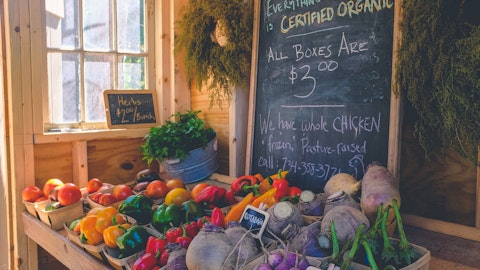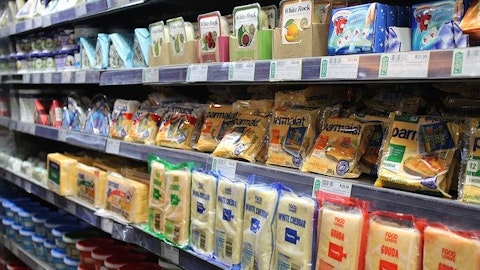Campbell Soup Company (NYSE:CPB) Q1 2023 Earnings Call Transcript December 7, 2022
Campbell Soup Company beats earnings expectations. Reported EPS is $1.02, expectations were $0.88.
Operator: Greetings, ladies and gentlemen, and welcome to the Campbell Soup Company First Quarter Fiscal 2023 Earnings Conference Call. At this time, all participants are in a listen-only mode. After today’s presentation, there will be an opportunity to ask questions. As a reminder, this conference call is being recorded. It is now my pleasure to introduce your host, Rebecca Gardy, Chief Investor Relations Officer. You may begin your conference.
Rebecca Gardy: Good morning, and welcome to Campbell’s first quarter fiscal year 2023 earnings conference call. I’m Rebecca Gardy, Chief Investor Relations Officer at Campbell Soup Company. I am joined today by Mark Clouse, Campbell’s President and Chief Executive Officer; and Mick Beekhuizen, Campbell’s Chief Financial Officer and President of Meals & Beverages. Today’s remarks have been prerecorded. Once we conclude our prepared remarks, we will transition to a live webcast Q&A session. The slide deck and today’s earnings press release have been posted to the Investor Relations section of our website, campbellsoupcompany.com. Following the conclusion of the Q&A session, a replay of the webcast will be available at the same location followed by a transcript of the call within 24 hours.
On our call today, we will be making forward-looking statements, which reflect our current expectations. These statements rely on assumptions and estimates, which could be inaccurate and are subject to risk. Please refer to Slide 3 or our SEC filings for a list of factors that could cause our actual results to vary materially from those anticipated in forward-looking statements. Because we use non-GAAP measures, we have provided a reconciliation of each of these measures to the most directly comparable GAAP measure in the appendix of this presentation. On Slide 4, you will see today’s agenda. Mark will share his perspective on our first quarter results as well as in-market performance by division. Mick will discuss the financial results of the quarter in more detail and then review our guidance for the full year fiscal 2023.
And with that, I am pleased to turn the call over to Mark.

pablo-merchan-montes-Orz90t6o0e4-unsplash
Mark Clouse: Thanks, Rebecca. Good morning, everyone, and thank you for joining our first quarter fiscal 2023 conference call. I hope you had a happy Thanksgiving and filled up on Green Bean casserole, Pepperidge Farm stuffing and plenty of our delicious snacks and cookies. As you read in our press release this morning, our fiscal year is off to a fast start. Our strong year-over-year performance across all three key reflects the continued strength of our portfolio and our successful efforts to substantially mitigate significant inflation through a combination of pricing and productivity improvements. I am also encouraged that we delivered those results while increasing investments in our brands and ensuring we remain a good value to consumers in this difficult economic time.
We also made significant progress on market share versus the fourth quarter, growing or holding share in most of our categories year-over-year. We are very pleased that the combination of stronger supply, accelerating innovation and appropriate investment is translating into strong profitable share growth as we had planned. Overall, Campbell’s portfolio continues to demonstrate compelling consumer relevance and is well positioned for the current economic environment. We recognize it’s still early in our fiscal year, and the environment does remain challenging. But given the strength of the first quarter performance, the health of our brands and our consistent execution, we’ve increased our guidance to reflect our current outlook. Mick will provide more details on the drivers shortly.
But this quarter’s results and the full year outlook demonstrate the significant progress we’ve made across our brands, supply chain, culture and capabilities. Although there remains more to do on the business as we continue unlocking our full growth potential, this quarter’s results represent a positive milestone in our journey. Organic net sales increased 15% to $2.6 billion due to both inflation-driven pricing and strong consumer demand. While we did see some volume declines, it was partially mitigated by expected retail inventory recovery and a strong rebound in unmeasured channels, especially food service. Dollar consumption was up 10% in the quarter versus the prior year and 21% versus three years ago. As expected, we shipped ahead of consumption in the quarter as our supply chain execution and service levels continue to improve, and retailers rebuild inventory levels.
The improved supply also allowed us to significantly increase our marketing investment in both divisions as planned. Turning to adjusted EBIT. Higher adjusted gross profit, partially offset by higher marketing and selling expenses and higher adjusted other expenses, resulted in a 15% increase in adjusted EBIT. The team has done an excellent job navigating inflation, leveraging a good balance of different tools. I also can see that our agility has improved in reacting to the volatile environment. As an example, we recently announced a very targeted Wave 4 pricing action on products where our input costs have gone up further. Adjusted earnings per share were $1.02 also up 15% as the flow-through of adjusted EBIT and lower weighted average diluted shares were partially offset by higher adjusted taxes.
I’m thrilled with our progress on dollar share. We grew our held share in most categories year-over-year and also grew share versus the prior quarter. In fact, 10 out of 15 of our key brands grew share in the quarter. Some of which responded faster and more significantly than expected as inventory and support were added. Even in categories where we experienced modest share declines such as soup and pretzels, our share performance improved sequentially as planned. There is no question that the focus of our portfolio from a category and geographic perspective is a distinct advantage right now and is enabling us to effectively deploy investment and drive consistently strong execution. Let’s look at our divisions. Starting with Meals & Beverages, which delivered a strong first quarter with reported and organic net sales growth of 15%.
In-market performance continues to show the underlying health of our portfolio with dollar consumption growing 8% over the prior year and up 17% versus three years ago. The recovery in our supply chain resulted in materially improved service levels, up over 18 points versus the prior year, enabling retailers to replenish inventory in the quarter and be well positioned on supply heading into the critical holiday season. We also saw a marked recovery in our foodservice business as supply has also improved in this important channel. Turning to Slide 10. Our strong dollar consumption growth was across most of our Meals & Beverages portfolio as we are well positioned within growing categories. The growth of our brands in key segments, namely ready-to-serve or RTS soups, Italian sauces, Mexican sauces and select segments in our condensed soup well outpaced the growth of their respective categories.
Turning to Slide 11. Our consumer insights show that consumers continue to cut back on out-of-home eating and are migrating from more expensive grocery categories as they seek ways to ease the impact of inflation. Consumers are making changes to stretch their budget and following several years of becoming more confident and comfortable with cooking, they continue to turn to our categories and importantly, our brands as evidenced by the continued growth of our Meals & Beverages business. With consumers preparing about 80% of meals from home, our brands are well positioned for sustained growth, delivering consumers the quality, value and convenience they seek for simple at-home meals and quick-scratch cooking. For example, our Spaghetti Carbonara recipe is a top performer year-over-year as it easily and economically feeds a family for about $1.53 a serving.
Turning to Slide 12. U.S. soup net sales grew 11% over the prior year, with gains in ready-to-serve, condensed and broth. We continue to see a favorable net pricing benefit with dollar consumption up 5%, partially offset by pricing-related volume declines. Elasticities remain below historical levels. And while our total dollar share of U.S. soup declined, it was by less than one point. We had positive dollar share growth in the quarter in key strategic segments, partially offset by competitive share losses to private label in total condensed and broth as expected. We continue to focus on price gaps and are adding equity support with meaningful innovation to maintain the strength of the category and our brands over the long run. Chunky continued its positive momentum with dollar share up 1.6 points in the quarter coming from strong base velocities as we further recovered on shelf, and 13% dollar consumption growth versus the prior year.
This was the fifth consecutive quarter Chunky held or gained volume share, reflecting the powerful combination of a strong base business, highly relevant innovation and increased investment in compelling advertising. Versus three years ago, Chunky grew dollar consumption by 26%. Our Chunky digital and social activations are seeing notable year-over-year increases in engagement and our lunchtime as your halftime campaign is resonating, particularly with younger consumers as we expand our reach through our NFL partnership and gaming via EA Madden. Closing out the slide, Pacific has returned to growth as a result of restored supply and innovation with dollar consumption of Pacific RTS soup up 21% versus prior year and share grew by 0.4 points in the quarter.
Pacific’s growth is outpacing organic sub-segments in the quarter, and the launch of RTS cans is the leading contributor to the growth with millennial buyers, up 16% versus prior year. Turning to the next slide and our progress on building a $1 billion sauce business, Prego continues to solidify our position as the branded dollar share leader in the Italian sauce category. Growth in the quarter was driven by both pricing and higher volume, reflecting improved service versus a year ago. The brand had strong in-market dollar consumption of plus 21% and share growth of 1.1 points versus prior year. Pace also performed well with dollar share gains of 0.4 points, marking the third consecutive quarter of dollar share growth and increased dollar consumption of 16%.
See also 12 Monthly Dividend Stocks Under $10 and 15 Best Cybersecurity Stocks To Buy.
Turning to snacks. We had an impressive quarter as our brands rapidly responded to the recovery of supply and increased investment with accelerated top line growth and share improvement. The strong 15% top line growth, which was fueled by our power brands, reflected pricing actions offset by slight pricing-related volume declines. Sales growth exceeded dollar consumption of 13% versus prior year due to the replenishment of retailer inventory, which have been depleted in the prior year due to supply challenges. As you’ll see on the next slide, in-market dollar consumption in our power brands was up 15%, with six of eight brands growing double digits. On a three-year basis, dollar consumption was up 28%, with all eight power brands growing double digits and four of our five salty power brands growing over 30%.
This also supports the historical learning that consumer snacking behavior is very resilient and relevant in tough economic environments. Overall, six of our eight power brands grew dollar share in the first quarter, including Cape Cod, Snack Factory and Lance, each of which grew share by over one point. As we have recovered from significant supply constraints that began in the second quarter of fiscal 2022, we began to see sequential dollar share improvement quarter-to-quarter. Specifically, over the last four quarters, Goldfish gained 0.6 points, Snyder’s of Hanover gained 3.5 points, Lance is up 4.8 points and Pepperidge Farm cookies were up 0.4 points. Our snack brands are also highly differentiated against competition with positive velocity trends.
In fact, on Slide 16, you’ll see that our brands are growing faster than their respective categories. And five out of seven power brand categories, including crackers, kettle chips, deli snacks, organic tortilla chips and sandwich crackers. Consumers continue to show their love for Goldfish and respond to the steps we’ve taken to broaden the appeal of this iconic brand. This is a remarkable growth story for one of our most important brands. We continue to deliver against our strategy to expand our consumer base with robust and relevant innovation and effective marketing that engages the entire family, not just younger kids. In fact, for the third time in a row, Goldfish crackers were teens most preferred snack brand according to Piper Sandler’s Fall 2022, taking stock with Teens survey.
Our Goldfish Dunkin’ Pumpkin Spice crackers were the top turning new cracker item and leading pumpkin spice stacking item during the quarter. We’ve continued this momentum with a new partnership with Disney Marvel and our limited edition Black Panther Wakanda Forever Goldfish, which hit the store shelves last month. And keep an eye out for the limited return of Goldfish Frank’s RedHot Crackers in the coming months. We also continued to win in salty snacks with dollar consumption and dollar share gains in Kettle Chips, Cape Cod, Snack Factory and Late July. Our Snack Factory Pretzel Chris and Snyder’s of Hanover will have new holiday activations inspiring new occasions and elevating every holiday snack trade. And finally, I want to highlight Pepperidge Farm cookies.
The holidays are their Super Bowl and with supply back, we’re able to return to full speed through the holidays. We’ve introduced new packaging designs across the portfolio from Milano to Chessman and brought back holiday favorites like lens or cookies. We also have new limited edition Milano Hazelnut Hot Cocoa, and with the return of the Milano Fancy Santa activation, we hope to do our share in making the holidays a little more special. In closing, I’m really pleased with our strong year-over-year performance and the fast start to the year. This is perhaps one of the most complete quarters we’ve delivered. We continue to build momentum and confidence with a powerful portfolio of brands in both divisions and the continued strength of our supply chain execution.
We’re recovering on share and driving growth in key categories. And with our portfolio focus, we are well positioned for the current consumer and economic environment. Our innovation is resonating with consumers, driving more engagement, especially among younger households and there’s more to come. It’s important to remember that there’s still much to do on our business, and the environment does remain challenging. But being able to face those challenges off a stronger and more stable foundation is very encouraging and bodes well for the future. Before turning it over to Mick, I wanted to comment on our recent management changes. As we announced in November, Mick has been appointed President, Meals & Beverages; and Chris Foley is now President of Snacks.
Mick will continue to serve as Chief Financial Officer until a successor to this role is in place. The search is going very well, and I look forward to updating you in the future. Both Mick and Chris have played a significant role in Campbell’s transformation over the last several years by enhancing our culture and improving our business performance. I’m confident that they are the right leaders to continue to build our momentum and unlock our full growth potential. In closing, I’d like to thank all of the Campbell’s team for their hard work and wish all of them and you happy holidays. With that, over to Mick.
Mick Beekhuizen: Thanks, Mark, and good morning, everyone. We are pleased by the strong results we delivered in the first quarter with 15% growth across all three key metrics: net sales, adjusted EBIT and adjusted EPS. Top line growth was due to inflation-driven pricing, sustained brand health and improved supply chain execution, partially offset by modest volume declines. First quarter net sales growth of 15% outpaced consumption growth due in part to retailer inventory rebuild as well as the strong recovery in our foodservice business. Strong sales growth, a relatively flat gross profit margin as cost inflation and unfavorable volume and mix were mostly mitigated by pricing and productivity improvements combined with continued support of our brands and expected lower pension income resulted in a 15% increase in adjusted EBIT.
On a margin basis, adjusted EBIT was comparable to the prior year at 17.4%. Adjusted EPS increased 15% to $1.02 per share, driven primarily by the increase in adjusted EBIT and partially offset by a higher adjusted effective tax rate. Our cash flow from operations in the first quarter was $227 million, which allowed us to continue to invest in the business while we returned over $150 million to our shareholders through dividends and share repurchases. With Q1 results ahead of expectations and our strong confidence in the health and momentum of our brands and improved supply chain, we feel it’s appropriate to raise our guidance. That said, let’s first discuss our first quarter results versus prior year in more detail. Net sales in the quarter, both reported and organic, increased 15%, driven by 16 points of inflation-driven pricing, this was partially offset by a one point volume and mix headwind.
Promotional spending in the quarter was down 1% in Meals & Beverages and up 1% in snacks and thus, overall comparable to the prior year. As an aside, going forward, we will combine the impact of promotional spending with the impact of pricing in our quarterly earnings materials. Turning to Slide 22. Our first quarter adjusted gross profit margin decreased 30 basis points from 32.5% to 32.2%. Inflation and higher other supply chain costs had a negative impact of 1,260 basis points with the majority of the impact driven by continued cost inflation as overall input prices on a rate basis increased by approximately 18%, which were slightly higher than the fourth quarter of fiscal ’22. Additionally, unfavorable volume and mix had a negative impact of 150 basis points in the quarter.
These factors were mostly mitigated by a higher net realized price, which drove an 1,140 basis point improvement, reflecting the impact of our inflation-driven pricing actions. In addition, our ongoing supply chain productivity and cost savings programs contributed 240 basis points to the adjusted gross profit margin. In the first quarter, we continued our efforts to mitigate inflation highlighted on the next page. Through a combination of targeted price increases and trade optimization as well as supply chain productivity improvements, cost savings initiatives and a continued focus on discretionary spending across the organization. As discussed during our previous earnings call, we expect cost inflation to continue throughout fiscal 2023. To mitigate the expected inflation, we are currently implementing selective additional pricing in both divisions, which should become effective in the second half of our fiscal year.
We continue to focus on all other areas of inflation mitigation while we diligently protect the important value proposition for consumers. Moving on to other operating items. Marketing and selling expenses increased 18% or $31 million and represented approximately 7.8% of net sales versus 7.6% in the prior year. The primary drivers of higher marketing and selling expenses were higher advertising and consumer promotion expense or A&C, which increased by 31% versus the moderated levels in the prior year and higher selling expenses, partially offset by increased benefits from cost savings initiatives. Administrative expenses on an adjusted basis increased 1% to $155 million due to higher general administrative costs and inflation, partially offset by lower expenses related to the settlement of certain legal claims.
As a percentage of net sales, adjusted administrative expenses were 6%, a 90 basis point decrease compared to last year. On Slide 25, we are providing an adjusted EBIT bridge to summarize the key drivers of performance this quarter. As previously mentioned, adjusted EBIT increased 15% in the quarter, primarily due to a 14% or $102 million improvement in adjusted gross profit. While the increase in adjusted gross profit benefited adjusted EBIT, it was lower as a percentage of net sales, resulting in a 30 basis point decrease of our adjusted gross profit margin and a corresponding decrease of our adjusted EBIT margin. Marketing and selling expenses increased $31 million versus the prior year and had a negative impact on our adjusted EBIT margin of 20 basis points.
Adjusted administrative and R&D expenses were $176 million, a 1% increase over prior year. This increase resulted in a 100 basis point contribution to the adjusted EBIT margin as these expenses were lower as a percentage of net sales versus prior year. Adjusted other expenses of $3 million compared to adjusted other income of $7 million in the prior year and a negative adjusted EBIT margin impact of 40 basis points. This headwind is largely due to a reduction in pension and postretirement benefit income compared to prior year. Our adjusted EBIT margin was in line with prior year at 17.4%. The following chart breaks down our adjusted EPS growth between operating performance and below the line items. Higher adjusted EBIT impact of $0.16 was partially offset by a $0.04 headwind of higher adjusted taxes.
Earnings per share also benefited from a reduction of the weighted average diluted shares outstanding. All in, adjusted EPS increased year-over-year by 15% to $1.02. Turning to Slide 27. Our Meals & Beverages division delivered a strong quarter with both reported and organic net sales increasing 15% versus prior year primarily due to increases in U.S. retail products, including soup and Prego pasta sauces as well as gains in our foodservice business. Inflation-driven pricing and sales allowances and lower levels of promotional spending were partially offset by volume declines. Sales of U.S. soup increased 11% due to sales increases in ready-to-serve soups, condensed soups and broth. Segment operating earnings in the quarter increased 18%. The increase was primarily driven by higher gross profit, partially offset by higher marketing and selling expenses.
Overall, within our Meals & Beverages division, first quarter operating margin increased year-over-year by 60 basis points to 22.7%. On Slide 28, reported and organic net sales in our Snacks division increased 15%, driven by sales of Power Brands, which were up 21% and Sales growth was driven by increases in cookies and crackers, primarily Goldfish crackers and in salty snacks, primarily in Snyder’s of Hanover pretzels and both Kettle brand and Cape Cod Potato Chips. Inflation-driven pricing and sales allowances were partially offset by volume declines and increased promotional spending relative to moderated levels in the prior year quarter. Segment operating earnings in the quarter increased 20%, primarily due to higher gross profit and lower administrative expenses, partly offset by higher marketing and selling expenses.
Overall, within our Snacks division, first quarter operating margin increased year-over-year by 50 basis points to 13.7%. And I’ll now turn to our cash flow and liquidity. Fiscal 2023 cash flow from operations decreased 21% year-over-year to $227 million, primarily due to changes in working capital, partially offset by higher cash earnings. Cash outflows from investing activities were reflective of the cash outlay for capital expenditures of $77 million, which was an increase from $69 million in the previous year. Cash outflows from financing activities were $127 million, including $115 million of dividends paid and $41 million of share repurchases. At the end of the first quarter, we had approximately $375 million remaining under the current $500 million strategic share repurchase program and approximately $131 million remaining on our $250 million anti-dilutive share repurchase program.
We ended the quarter with cash and cash equivalents of $130 million. Before I turn to guidance, I wanted to touch on a few additional items. First, at the end of September, S&P Global upgraded our credit rating to BBB with a stable outlook. Secondly, on November 15, we raised a delayed draw term loan totaling up to $500 million. We plan to use the proceeds of the loan to refinance our existing $566 million notes maturing in March 2023. And lastly, on November 21, we entered into a 12-year renewable power purchase agreement with Enel North America to support our goal to reduce greenhouse gas emissions. Improving the sustainability of the agriculture and food value chain is important to Campbell, and this agreement is a substantial step forward in meeting our science-based emissions reduction target.
With that, let’s turn to Slide 30. As previously mentioned, we are raising our financial guidance for the year given the strength of our first quarter performance, the health of our brands and our consistent execution. For the full year, we now expect net sales both organic and reported to be plus 7% to plus 9%, adjusted EBIT of plus 2.5% to plus 6.5% and adjusted EPS of plus 2% to plus 5%. First, the fiscal 2022 results, resulting in fiscal 2023 adjusted EPS of $2.90 to $3. Lastly, as we mentioned on our fourth quarter call, our guidance reflects an approximate 3% headwind to adjusted EBIT and adjusted EPS from lower pension and post retirement income. All in, we’re off to a great start to fiscal 2023 and are confident in our strategy and execution.
As Mark mentioned, while we expect the environment to remain dynamic, our brand momentum remains strong as both supply and investment returned to pre-pandemic levels. I’d like to close by thanking all our teams for their commitment and wishing everyone a wonderful holiday season. And with that, let me turn it over to the operator to begin Q&A.
Q&A Session
Follow Campbell Soup Co (NYSE:CPB)
Follow Campbell Soup Co (NYSE:CPB)
Operator: Your first question comes from the line of Andrew Lazar from Barclays. Your line is open.
Andrew Lazar: To start off, I guess, last quarter, I think, Mark, you mentioned that you expected sequential improvement in gross margins as the year progressed. Given how much better gross margins came in, in 1Q, I’m trying to get a sense of if that’s still the case; and if so, if that would mean your full year gross margins could be better than the flattish outlook that you gave last quarter? So, I’m basically trying to get a sense of just sort of the cadence over the next couple of quarters in terms of the margin profile? And then I’ve got a quick follow-up.
Mark Clouse: Yes, that’s — yes. No, I got — great question, Andrew. I guess maybe let me start with a little bit of what was better in Q1 than perhaps we had expected. I think it really does begin with top line. We were stronger performance on the top line, really driven by two things. I think the first was better in market, lower elasticity than we had expected paired with the marketing effectiveness. I’m always a little bit tough to tease those two things out. But at the end of the day, that in-market performance share recovery was stronger and faster than we had expected. I think the second area is we continue to execute really well on the supply chain. And the recovery in supply was fast enough that it allowed us to accelerate availability both for that inventory that we had planned.
But also you saw places like unmeasured channels growing even faster than we had anticipated. In particular, foodservice was very, very strong. And as you drop that down into margin and you say, okay, top line better, how to — what was different in the margin. As you know, when you get that top line going, there’s a lot of positive effects throughout the P&L. And I do think, consistent with that, we saw greater efficiency. And again, I do think the execution across the Company has been very strong as well, whether it was the execution of pricing or Wave 3, whether it was our supply chain. I think, the combination of those elements were all very positive, and it did result in a better top line and a better margin than we had initially expected.
I do think as you look out then across the balance of the year, what we would continue to expect, I’m not making a broad balance of the year move in our elasticity assumptions. In fact, you would have heard Mick talk a little bit in his comments about some pockets of increases in inflation that are resulting in a Wave 4, although very targeted, still a bit more pricing that we’re in the midst of executing right now. And so balancing that ongoing view of consumer resilience, I think we’re being pragmatic and not necessarily carrying that elasticity favorability through the year. I think then if you start to say, okay, well, how does that kind of play out across the year. As you think about the next quarter, I think the two things you’ll see that are going to be a little different than Q1 and is you won’t have the inventory recovery opportunity, and you probably will see a little bit of modest increase in promotional spend and the continued kind of investment in the year, and that might be a little different than what you saw in Q1.
And then, of course, as you get to the back half of the year, you’re beginning to lap the significant pricing from a year ago as well as some tougher comps to get through. I think the net of this I just would say is that we are in Q1. This does remain a pretty volatile environment. I think we’ve tried to be appropriately pragmatic and looking at the balance of the year. But if you take our guidance versus where we were, it does imply, and I think a little bit of this is the way for pricing and inflation dynamic. If you take the midpoint of the two guidance ranges, we’re about 20 bps actually lower in margin assumption for the year. And that is a little bit of reflective of the dynamics that I just explained. But like I said, it’s very early in the year.
And I think we — the good news is we feel great about starting really on our front foot and the things that we can control, we really saw positive performance across those variables in the Q1. And that certainly does give us greater confidence heading into the balance of the year based on where we are today.
Operator: Your next question comes from the line of Ken Goldman from JPMorgan. Your line is open.
Ken Goldman: We’ve seen some of your competitors in soup and broth be maybe a bit more aggressive with pricing on shelf lately. I’m just curious, is there anything you’re seeing that’s surprising in terms of competitive levels in these categories? And as we head into 2Q, are you hearing anything or seeing anything that would suggest that as you get more promotional as well, which you mentioned, that maybe your competitors will do the same or step it up even more.
Mark Clouse: Yes. I would say, first off, just to kind of make sure I appropriately caveat this. Everything that we’re doing as it relates to an investment side, especially on the promotional side, would be very responsive to the marketplace, very modest in the sense of it being quite normal and just kind of how supply has recovered. This is not a overly aggressive stance or one that we’re trying necessarily to distort a position as it relates to share or market because we don’t really need it. I think the — the reality is that the combination of the marketing, innovation and what we’re doing on the brands have been very effective. And again, with my druthers, I’d rather be supporting the equity side. But at the end of the day, it’s important that we stay very vigilant on the price gaps.





